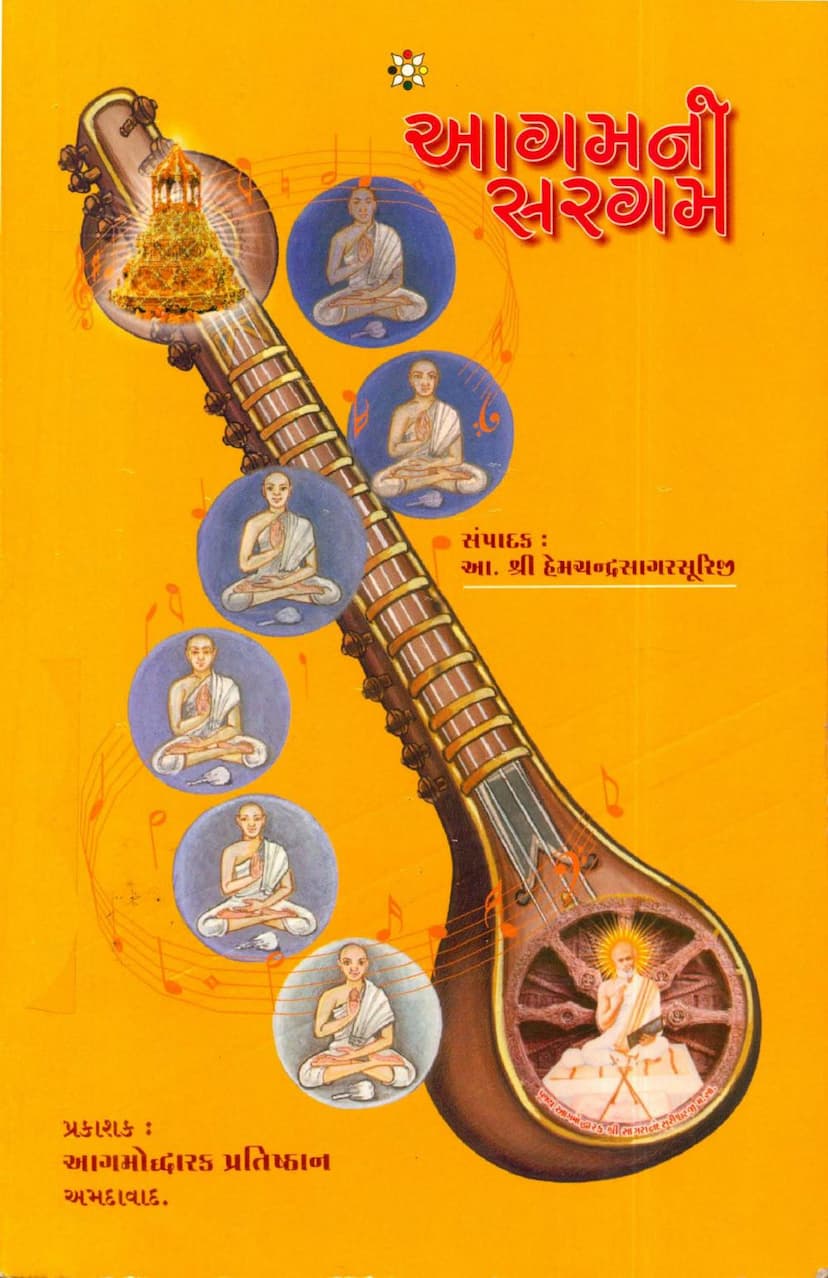Agamni Sargam
Added to library: September 1, 2025

Summary
Based on the provided text, here is a comprehensive summary of the Jain text "Agamni Sargam" by Hemchandrasagarsuri, published by Agamoddharak Pratishthan:
Title: Agamni Sargam (The Melody of the Agamas)
Author/Editor: Acharya Shri Hemchandrasagarsuri Ji (also listed as Acharya Shri Hemchandrasuri Ji)
Publisher: Shri Agamoddharak Pratishthana, Ahmedabad
Foreword: The book includes a message from Narendra Modi, the then Chief Minister of Gujarat, highlighting the unity in diversity of religions in India and expressing hope that the book will provide knowledge of the Agam texts to both Jain and non-Jain readers.
Core Content:
The primary purpose of "Agamni Sargam" is to provide a comprehensive overview of the Jain Agamas. It focuses on:
-
Agam Vachanas (Recitations/Councils): The book details the six major Agam recitations held within one thousand years of Lord Mahavir's nirvana. It also touches upon the Vachanas conducted by Pujya Agamoddharak Shri Anandasagarsuri Maharaj.
-
Introduction to 45 Agamas: The book offers a concise introduction to the 45 principal Agam texts of Jainism.
-
The Legacy of Agamoddharak Shri Anandasagarsuri Maharaj: A significant portion of the book is dedicated to honoring and elaborating on the life, work, and immense contribution of Pujya Agamoddharak Shri Anandasagarsuri Maharaj. He is portrayed as a monumental figure who dedicated his life to the preservation and propagation of the Agamas.
- His Life and Teachings: The text describes him as a knowledgeable, righteous, influential, and prolific scholar. His life was a testament to high ideals, and he is seen as a warrior for the Agamic tradition, a creator of elemental literature, and the backbone of Jainism. He lived in a way that reflected the grandeur of the past and foreshadowed the greatness of the future.
- His Role as an "Agamoddharak" (Uplifter of Agamas): The book highlights his pivotal role in safeguarding and revitalizing the Agamic tradition, especially in the face of declining scriptural knowledge over centuries.
- His Efforts in Popularizing Agamas: The text details his efforts in organizing widespread Agam recitations and studies. A significant event mentioned is a three-day celebration in Palitana following his 50th death anniversary, which included a grand chariot procession of 45 Agamas, elaborate pujas, and discourse sessions by prominent Acharyas.
- Agam-Parichay Vachanas: The book elaborates on the initiative to conduct systematic recitations of the 45 Agamas, where different Acharyas would present a concise introduction to each Agam. This was a major undertaking that fostered unity and deep engagement with the scriptures.
- Creation of Agam Mandirs: To ensure the longevity and preservation of the Agamas, he initiated the construction of Agam Mandirs (temples of Agamas) where the sacred texts were inscribed on stone and copper plates. The Agam Mandir in Palitana (housing 45 Agamas inscribed on marble) and the Agam Mandir in Surat (with Agamas on copper plates) are specifically mentioned as his significant contributions.
-
Detailed Description of Six Major Agam Recitations: The book provides a historical account of six significant Agam recitations that occurred between Lord Mahavir's nirvana and the first millennium. These recitations were crucial for preserving the Agamic knowledge due to various challenges like famines, political turmoil, and the decline in memorization capacity among monks.
- The first recitation was held in Pataliputra under Sthulabhadra Swami due to a 12-year famine, aimed at compiling the Dwadashangi.
- Subsequent recitations are described, including those under Samrati Sammiti, Maharaja Kharvel, and others, highlighting the continuous efforts to safeguard the Agamas.
- The text emphasizes the importance of these recitations in maintaining the integrity and transmission of the Jain scriptures through the ages.
-
Introduction to Key Agamic Texts (Summarized): The book then provides a concise summary of several important Agam texts, including:
- Eleven Angas: A brief description of each of the 11 primary Angas (Acharangasutra, Sutrakrutanga, Sthanangasutra, Samavayangasutra, Vyakhyaprajnapti/Bhagavati, Jnatadharmakathan, Upasakadashanga, Antakruddasha, Anuttaraupapataikadasha, Prashnavyakarana, and Vipaka-Shruta).
- Twelve Upangas: Briefly outlines the Upangas like Oupapatika, Rajprashniya, Jivabhigama, Prajnapana, Chandrasuryaprajnapti, Jambudvipa-prajnapti, Nirayavalika, Kalpavatamsika, Pushpika, Pushpachulika, Vanhidasha, and Dhrishtivada (as an Upanga in this context).
- Ten Panna (Prakirnak): Introduces the Panna texts, emphasizing their role in guiding spiritual practice and achieving liberation. Specific Panna mentioned include Chatursharan, Aturpratyakhyana, Mahapratyakhyana, Bhaktaparigraha, Tandulavaicharika, Samtaraka, Gachchachara, Ganividya, Devendrastava, and Maranasamadhi.
- Four Mul Sutras: Introduces the four foundational texts: Avashyakasutra, Dashavaikalika, Pindaniryukti, and Uttaradhyayana.
- Six Ched Sutras: Briefly describes the purpose and content of the six Ched Sutras: Nishithasutra, Brihatkalpasutra, Vyavaharasutra, Dashashrutaskandha, Jitakalpa/Panchakalpa, and Mahanishithasutra.
- Nandi Sutra and Anuyogadvara Sutra: These are presented as crucial texts for understanding the Agamas, with Nandi Sutra being the "gateway" and Anuyogadvara Sutra being the "master key" for comprehending the Agamic philosophy.
Overall Theme:
"Agamni Sargam" is a tribute to the Agamas and the profound efforts made by Jain Acharyas, particularly Anandasagarsuri Maharaj, to preserve, protect, and disseminate this invaluable spiritual heritage. It underscores the importance of these scriptures for spiritual upliftment and liberation, encouraging readers to delve into their study and practice. The book serves as a guide and an inspiration to understand and appreciate the vastness and depth of Jain Agamic literature.